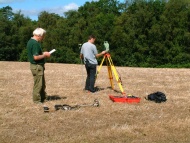If you wish to contribute or participate in the discussions about articles you are invited to contact the Editor
Surveying, Mapping and GIS Applications: Difference between revisions
No edit summary |
Rui.Pereira (talk | contribs) mNo edit summary |
||
| Line 8: | Line 8: | ||
}} | }} | ||
One of the most obvious | One of the most obvious uses for GNSS systems is the realization of surveys and production of maps. Although a simple standalone [[:Category:Receivers|GNSS Receiver]] might not have the required precision for some survey requirements, most of these requirements can be fulfilled using high-end dual frequency multi-constellation receivers built specifically for surveying and by using [[GNSS Augmentation]] techniques. | ||
The use of GNSS techniques in geodesy have revolutionized the way geodetic measurements are made. An increasing number of national governments and regional organizations are using GNSS measurements as the basis for their geodetic networks<ref> [http://www.oosa.unvienna.org/pdf/publications/st_space_24E.pdf GNSS Follow-up to the Third United Nations Conference on the Exploration and Peaceful Uses of Outer Space (UNISPACE III) - Report of the action team on Global Navigation Satellite Systems (GNSS)], UN, ST/SPACE/24, 2004.</ref>. | The use of GNSS techniques in geodesy have revolutionized the way geodetic measurements are made. An increasing number of national governments and regional organizations are using GNSS measurements as the basis for their geodetic networks<ref> [http://www.oosa.unvienna.org/pdf/publications/st_space_24E.pdf GNSS Follow-up to the Third United Nations Conference on the Exploration and Peaceful Uses of Outer Space (UNISPACE III) - Report of the action team on Global Navigation Satellite Systems (GNSS)], UN, ST/SPACE/24, 2004.</ref>. | ||
| Line 51: | Line 51: | ||
[[Category:Applications]] | |||
[[Category:Surveying, Mapping and GIS Applications]] | [[Category:Surveying, Mapping and GIS Applications]] | ||
Revision as of 15:12, 22 July 2011
| Applications | |
|---|---|
| Title | Surveying, Mapping and GIS Applications |
| Author(s) | GMV. |
| Level | Medium |
| Year of Publication | 2011 |
One of the most obvious uses for GNSS systems is the realization of surveys and production of maps. Although a simple standalone GNSS Receiver might not have the required precision for some survey requirements, most of these requirements can be fulfilled using high-end dual frequency multi-constellation receivers built specifically for surveying and by using GNSS Augmentation techniques.
The use of GNSS techniques in geodesy have revolutionized the way geodetic measurements are made. An increasing number of national governments and regional organizations are using GNSS measurements as the basis for their geodetic networks[1].
Land Surveying
Land Surveying is the processes of measuring the distances and angles between different points, on the surface of Earth. Satellite navigation has been extensively used by land surveyors since the late 1980s, primarily for geodetic control networks and for photo control.
Nowadays, GNSS is used to determine precise locations all over the globe, in any weather conditions. It is faster than other surveying methods, but it is not as accurate without with proper augmentation techniques.
GNSS systems are now available for many surveying tasks, including establishing control, setting out, real-time deformation monitoring, or on-board camera positioning for aerial photography.
Detailed information about Land Surveying can be found here.
Mapping & GIS
Detailed information about Mapping & GIS can be found here.
Deformation Monitoring
Detailed information about Deformation Monitoring can be found here.
Maritime Surveying
Detailed information about Maritime Surveying can be found here.
Aerial Photogrammetry
Detailed information about Aerial Photogrammetry can be found here.
Aerial Laser Profiling
Detailed information about Aerial Laser Profiling can be found here.
Archeology
Detailed information about Archeology can be found here.
Notes

